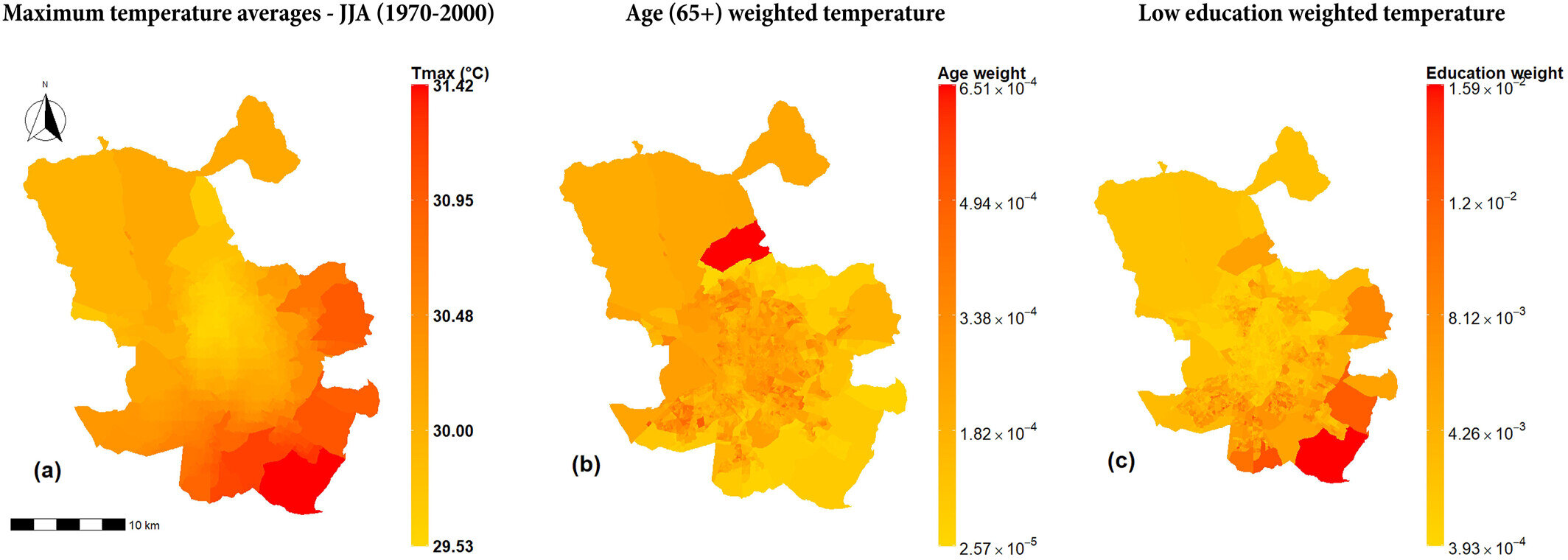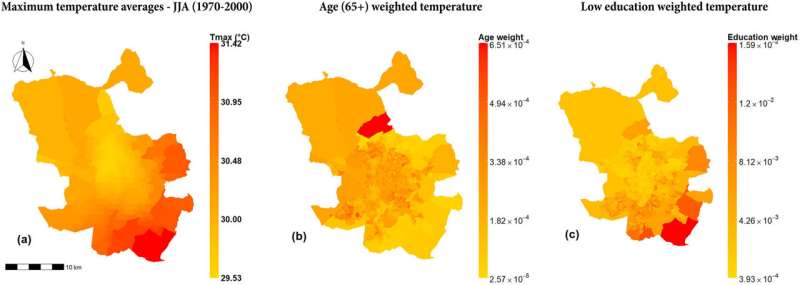
by Miriam Stackpole Dahl, Centre for International Climate and Environmental Research (CICERO)

Heat-related deaths and diseases are a major concern in Europe amid increasing extended periods of extreme heat. A recent study proposes a novel way of quantifying and projecting future vulnerability to heat stress in different areas of a city, providing local decision-makers with knowledge for designing more effective adaptation strategies to minimize health impacts of heat stress.
“Climate change-induced heat stress is a major risk factor for human health, especially in cities where more people are exposed to increasingly higher temperatures in the warm season. Cities are usually hotter than surrounding rural areas due to dark and impenetrable surfaces that absorb more heat,” explained researcher Iulia Marginean from CICERO Center for International Climate Research, the lead author of the vulnerability study published 6 October in Earth’s Future.
The study highlights that vulnerability is an understudied component of climate risk, but a crucial one in climate impact assessments as it plays a key role in determining the magnitude of heat stress impacts on public health.
“Growing concerns of heat-related death and disease in Europe calls for more effective adaptation solutions targeting the groups and individuals most at risk and most affected by the negative impacts of climate change,” emphasized Roman Hoffmann, from the International Institute for Applied Systems Analysis (IIASA), another author behind the study.
In 2023, more than 47,000 people died in Europe as a result of heat, but many more would have died if people had not adapted better to rising temperatures in the past two decades, according to another recent study. Spain is one of the countries with the highest heat-related mortality rates in Europe. This year many Spanish cities, among them its capital city, Madrid, have experienced extended periods of extreme heat.
“Decision-makers need detailed local information on demographic characteristics underlying vulnerability to know towards whom and where they should target their adaptation efforts. However, often the assessment of heat risk is focusing on the hazard at city level and not on population vulnerability, which can vary between groups and geographical areas,” explained Raya Muttarak, co-author from the University of Bologna.
For example, people above the age of 65, those with low socioeconomic status and women are known to be more disposed to heat-related illness and mortality. Moreover, heat stress intensity varies greatly from one neighborhood to another and even within neighborhoods of a city.
“We have developed a novel framework for assessing vulnerability in cities using spatial and demographical data such as age, sex and education at fine geographical resolutions to estimate future heat stress vulnerabilities in different parts of a city,” said Jesus Crespo Cuaresma from Vienna University of Economics and Business.
The study was conducted by researchers from CICERO, University of Oslo, Vienna University of Economics and Business, International Institute of Applied Systems Analysis (IIASA), University of Bologna and University of Delaware.
Heat stress vulnerability in Madrid, now and in the future
The study uses Madrid as a case study, and the results show that vulnerability to heat stress varies strongly across different areas in the city and even within a single neighborhood. The researchers use novel methods and different future scenarios to provide projections of vulnerability at a high spatial resolution. They find that areas that are vulnerable to heat stress today are expected to become even more vulnerable in the future if emissions are not reduced rapidly and substantially.
“More effective adaptation strategies that target the most vulnerable where they are, are needed to cope with the increased heat stress that cities, especially in Southern Europe, are now faced with. But the most effective way of reducing vulnerability to heat stress is to follow a sustainable development pathway with rapid reduction of emissions,” says Marginean.
What neighborhoods in Madrid are most at risk for health impacts of heat stress?
The study finds a concentration of vulnerable populations, measured by their age, sex and educational level, in some of Madrid’s most disadvantaged neighborhoods. The population in the central districts and northern parts of Madrid face higher heat stress due to their relatively old age.
In the neighborhood of El Goloso, 73 percent of its inhabitants are 65 years or older and thus this neighborhood has the highest risk related to age. The south-eastern parts of Madrid face high risks of being unable to cope with heat due to the relatively low socio-economic status, with a high share of population with low education. This is particularly true for district 18, Villa de Vallecas.
More information:
I. Marginean et al, High‐Resolution Modeling and Projecting Local Dynamics of Differential Vulnerability to Urban Heat Stress, Earth’s Future (2024). DOI: 10.1029/2024EF004431
Provided by
Centre for International Climate and Environmental Research (CICERO)
Citation:
New tool provides knowledge on heat stress vulnerability in cities for more targeted adaptation (2024, October 9)
retrieved 9 October 2024
from https://phys.org/news/2024-10-tool-knowledge-stress-vulnerability-cities.html
This document is subject to copyright. Apart from any fair dealing for the purpose of private study or research, no
part may be reproduced without the written permission. The content is provided for information purposes only.